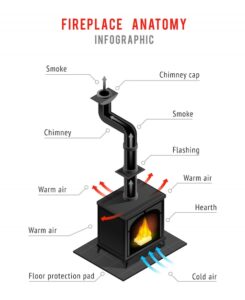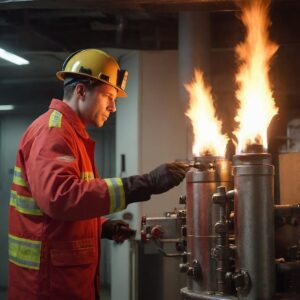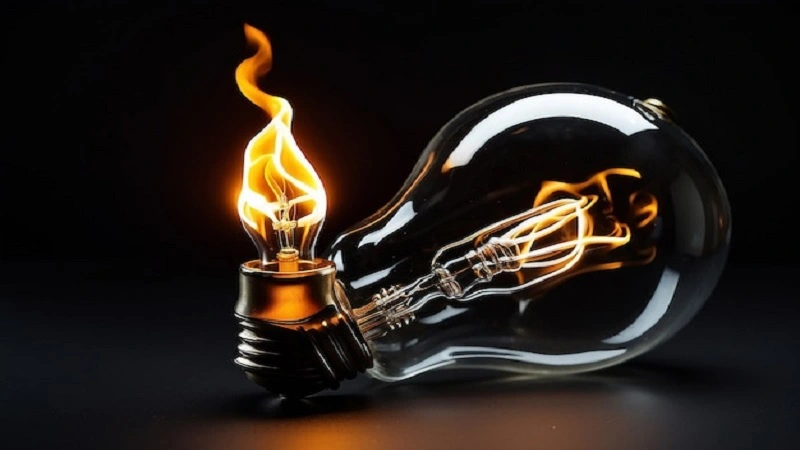Flame rectification is a fundamental process used in modern combustion systems. It ensures both safety and efficiency in various applications, including gas furnaces, industrial burners, and boilers. This article provides an in-depth look at it, exploring its principles, applications, and recent technological advancements. With a focus on clear and engaging information, this comprehensive guide aims to help you understand the crucial role of it.
Basic Principles of Flame Rectification
It is based on the principle of electrical conductivity. When a flame is present, it ionizes the air around it. This ionization creates a conductive path for an electrical current. The flame sensor detects this current, confirming the presence of a flame.
How Flame Rectification Works
The flame rectification process involves several key steps:
Detection of Flame Rectification
The flame sensor detects the flame by measuring its electrical conductivity. As the flame ionizes the air, it allows a small electrical current to flow through it. The sensor picks up this current and sends a signal to the control module.
Signal Processing
The control module receives the signal from the flame sensor. It interprets the signal to determine whether the flame is present. If the signal indicates a stable flame, the control module allows the burner to continue operating. If the signal is weak or absent, the control module shuts down the burner to prevent potential hazards.

Safety and Efficiency Considerations
Proper flame detection is essential for safety and efficiency. An accurate flame rectification system ensures that the combustion process is safely managed. It also helps maintain the efficiency of the system by ensuring that it operates only when a stable flame is present.
Table 1: Components of Flame Rectification System
| Component | Description |
|---|---|
| Flame Sensor | Detects the presence of a flame through electrical conduction. |
| Control Module | Processes signals from the flame sensor to control the burner. |
| Electrodes | Conduct electrical signals to and from the flame sensor. |
Understanding these components is crucial for grasping how it ensures safe and efficient combustion.
Applications of Flame Rectification
it plays a vital role in various applications, enhancing both safety and performance.
Gas Furnaces
In gas furnaces, it is used to ensure safe operation. The system verifies that a flame is present before allowing the furnace to continue operating. This prevents the buildup of unburned gas, which can be dangerous. By ensuring proper ignition, flame rectification helps maintain the efficiency of the furnace.
Industrial Burners
For industrial burners, fit is crucial for improving efficiency. It ensures that the burner operates only when a stable flame is present. This reduces fuel wastage and enhances the overall performance of the burner. In industrial settings, where efficiency is critical, it helps in achieving optimal combustion.

Boilers and Water Heaters
In boilers and water heaters, flame rectification ensures reliable performance. It verifies the presence of a flame before activating the heating elements. This helps prevent potential hazards and ensures consistent performance. For residential and commercial systems, reliable it contributes to safe and efficient operation.
Table 2: Applications and Benefits of Flame Rectification
| Application | Benefits |
|---|---|
| Gas Furnaces | Enhances safety and ensures proper ignition. |
| Industrial Burners | Increases operational efficiency and reduces downtime. |
| Boilers/Water Heaters | Ensures consistent and reliable performance. |
These applications demonstrate how it contributes to safety and efficiency in various systems.
Flame Rectification Process
Its process involves several stages, each crucial for maintaining safe and efficient operation.
Flame Detection Mechanism in Flame Rectification
The flame sensor detects the presence of a flame through electrical conductivity. When a flame is present, it ionizes the air, creating a path for the electrical current. The sensor measures this current and sends a signal to the control module. This signal indicates whether the flame is stable and properly ignited.
Signal Processing
The control module processes the signals received from the flame sensor. It determines whether to keep the burner active based on the strength of the signal. If the signal indicates a stable flame, the burner remains operational. If the signal is weak or absent, the control module shuts down the burner to prevent potential risks.
Safety and Efficiency Considerations
Proper flame detection is crucial for both safety and efficiency. An accurate flame rectification system ensures that combustion systems operate safely, reducing the risk of accidents. It also helps maintain efficiency by ensuring that the system runs only when a stable flame is present.
Table 3: Flame Detection Process
| Step | Description |
|---|---|
| Detection | Flame sensor detects electrical conductivity in the flame. |
| Signal Processing | Electrical signals are processed by the control module. |
| Safety Checks | System verifies the presence of a flame for safe operation. |
These stages highlight the importance of flame detection in maintaining safe and efficient combustion processes.
Common Issues and Troubleshooting
Its systems can encounter several common issues. Identifying and addressing these issues is essential for maintaining system performance.
Common Problems
Sensor Failure
A common issue with it systems is sensor failure. This can occur due to dirt, damage, or other factors. When the sensor fails, it may not detect the flame properly, leading to operational issues.
Signal Interference
Signal interference can also affect the performance of flame rectification systems. Interference can come from various sources, including electrical noise or faulty wiring. This can lead to inconsistent flame detection or false alarms.
Improper Installation
Improper installation of the flame sensor can lead to problems. If the sensor is not aligned correctly or installed according to specifications, it may not detect the flame accurately.
Diagnostic Techniques
To diagnose these issues, several techniques can be used:
Check the Flame Sensor
Inspect the flame sensor for dirt or damage. Cleaning the sensor or replacing it if necessary can resolve issues related to sensor failure.
Inspect Wiring
Examine the wiring for signs of interference or damage. Ensuring proper grounding and connections can help address signal interference issues.
Verify Installation
Check the alignment and installation of the flame sensor. Reinstalling the sensor according to the manufacturer’s specifications can resolve problems related to improper installation.
Solutions and Repairs
Cleaning or Replacing the Flame Sensor
If the flame sensor is dirty or damaged, cleaning it or replacing it can restore proper functionality. Regular maintenance helps prevent sensor-related issues.
Correcting Wiring Problems
Addressing wiring problems, such as poor connections or interference, can improve signal quality and reduce false alarms. Properly grounded wiring ensures accurate flame detection.
Reinstalling the Sensor
If the sensor is improperly installed, reinstalling it according to the manufacturer’s specifications can resolve alignment issues. Proper installation is crucial for accurate flame detection.
Table 4: Common Issues and Solutions
| Issue | Symptoms | Solution |
|---|---|---|
| Sensor Failure | No flame detected despite ignition. | Check and clean the flame sensor; replace if necessary. |
| Signal Interference | Inconsistent flame detection or false alarms. | Inspect wiring and connections; ensure proper grounding. |
| Improper Installation | Flame sensor not properly aligned or installed. | Reinstall sensor according to manufacturer specifications. |
Addressing these common issues helps ensure that its systems remain reliable and efficient.
Advances in Flame Rectification Technology
Recent advancements in it technology have improved both efficiency and safety. These innovations offer new solutions and enhance system performance.
New Developments
Improved Sensors
Recent advancements include improved sensors with enhanced sensitivity and accuracy. These sensors provide more reliable flame detection, reducing the risk of false alarms and improving overall performance.
Advanced Algorithms
New signal processing algorithms enhance the ability to detect flames more accurately. These algorithms help in distinguishing between real flames and false signals, leading to better system performance.
Integration with Smart Systems
its systems are increasingly being integrated with smart technology. This integration allows for enhanced connectivity and control, providing real-time monitoring and adjustments.
Impact on Efficiency and Safety
These technological advancements have a significant impact on both efficiency and safety. Improved sensors and algorithms lead to more accurate flame detection, reducing fuel wastage and enhancing overall system performance. Integration with smart systems provides better control and monitoring, contributing to safer and more efficient operation.
Future Trends
Future trends in flame rectification technology may include further advancements in sensor technology and increased use of smart systems. These developments could lead to even more efficient and reliable it systems, offering enhanced performance and safety.
Table 5: Recent Technological Advancements
| Advancement | Description |
|---|---|
| Improved Sensors | New sensors with enhanced sensitivity and accuracy. |
| Advanced Algorithms | More sophisticated signal processing for better detection. |
| Integration with Smart Systems | Enhanced connectivity and control through smart technology. |
These advancements highlight the ongoing improvements in it technology and their potential impact on future systems.
FAQs About Flame Rectification
What is the Purpose of Flame Rectification?
Flame rectification ensures that combustion systems operate safely and efficiently. It detects the presence of a flame and prevents the operation of the burner if a stable flame is not detected.
How Do I Know If My Flame Rectification System is Faulty?
Signs of a faulty flame rectification system include inconsistent flame detection, false alarms, or the burner failing to ignite. Regular maintenance and inspections can help identify these issues.
Can Flame Rectification Systems Be Used with All Types of Burners?
Flame rectification systems are compatible with most types of burners. However, compatibility should be confirmed based on the specific requirements of the system and manufacturer’s recommendations.
How Often Should Flame Rectification Systems Be Maintained?
Regular maintenance is recommended for flame rectification systems, typically once a year. Regular checks help ensure optimal performance and safety.
Are There Any Safety Concerns with Flame Rectification Systems?
While flame rectification systems are generally safe, improper installation or maintenance can lead to issues. Following manufacturer guidelines and performing regular maintenance help mitigate these risks.
Conclusion
Flame rectification is a crucial technology for ensuring the safety and efficiency of combustion systems. Understanding its principles, applications, and recent advancements provides valuable insights into its role in modern systems. As technology continues to evolve, flame rectification systems will likely become even more efficient and reliable. Staying informed about technological advancements and adhering to best practices will help maintain optimal performance and safety.
References and Further Reading
Key References
List of academic papers, articles, and industry standards related to flame rectification]
Additional Resources



